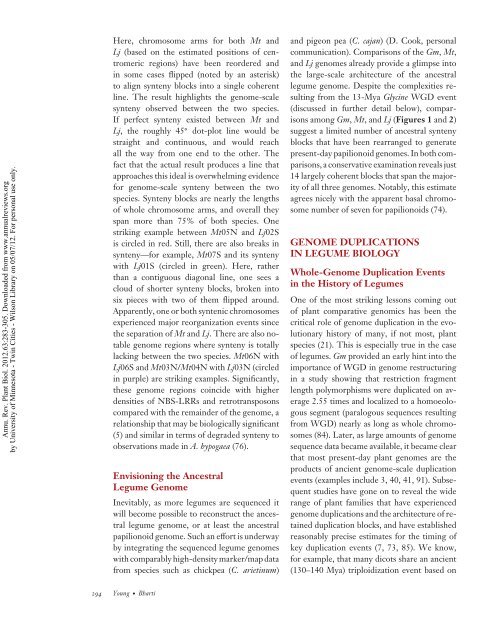Genome-Enabled Insights into Legume Biology - University of ...
Genome-Enabled Insights into Legume Biology - University of ...
Genome-Enabled Insights into Legume Biology - University of ...
You also want an ePaper? Increase the reach of your titles
YUMPU automatically turns print PDFs into web optimized ePapers that Google loves.
Annu. Rev. Plant Biol. 2012.63:283-305. Downloaded from www.annualreviews.org<br />
by <strong>University</strong> <strong>of</strong> Minnesota - Twin Cities - Wilson Library on 05/07/12. For personal use only.<br />
Here, chromosome arms for both Mt and<br />
Lj (based on the estimated positions <strong>of</strong> centromeric<br />
regions) have been reordered and<br />
in some cases flipped (noted by an asterisk)<br />
to align synteny blocks <strong>into</strong> a single coherent<br />
line. The result highlights the genome-scale<br />
synteny observed between the two species.<br />
If perfect synteny existed between Mt and<br />
Lj, the roughly 45 ◦ dot-plot line would be<br />
straight and continuous, and would reach<br />
all the way from one end to the other. The<br />
fact that the actual result produces a line that<br />
approaches this ideal is overwhelming evidence<br />
for genome-scale synteny between the two<br />
species. Synteny blocks are nearly the lengths<br />
<strong>of</strong> whole chromosome arms, and overall they<br />
span more than 75% <strong>of</strong> both species. One<br />
striking example between Mt05N and Lj02S<br />
is circled in red. Still, there are also breaks in<br />
synteny—for example, Mt07S and its synteny<br />
with Lj01S (circled in green). Here, rather<br />
than a contiguous diagonal line, one sees a<br />
cloud <strong>of</strong> shorter synteny blocks, broken <strong>into</strong><br />
six pieces with two <strong>of</strong> them flipped around.<br />
Apparently, one or both syntenic chromosomes<br />
experienced major reorganization events since<br />
the separation <strong>of</strong> Mt and Lj.Therearealsonotable<br />
genome regions where synteny is totally<br />
lacking between the two species. Mt06N with<br />
Lj06S and Mt03N/Mt04N with Lj03N (circled<br />
in purple) are striking examples. Significantly,<br />
these genome regions coincide with higher<br />
densities <strong>of</strong> NBS-LRRs and retrotransposons<br />
compared with the remainder <strong>of</strong> the genome, a<br />
relationship that may be biologically significant<br />
(5) and similar in terms <strong>of</strong> degraded synteny to<br />
observations made in A. hypogaea (76).<br />
Envisioning the Ancestral<br />
<strong>Legume</strong> <strong>Genome</strong><br />
Inevitably, as more legumes are sequenced it<br />
will become possible to reconstruct the ancestral<br />
legume genome, or at least the ancestral<br />
papilionoid genome. Such an effort is underway<br />
by integrating the sequenced legume genomes<br />
with comparably high-density marker/map data<br />
from species such as chickpea (C. arietinum)<br />
and pigeon pea (C. cajan) (D. Cook, personal<br />
communication). Comparisons <strong>of</strong> the Gm, Mt,<br />
and Lj genomes already provide a glimpse <strong>into</strong><br />
the large-scale architecture <strong>of</strong> the ancestral<br />
legume genome. Despite the complexities resulting<br />
from the 13-Mya Glycine WGD event<br />
(discussed in further detail below), comparisons<br />
among Gm, Mt,andLj (Figures 1 and 2)<br />
suggest a limited number <strong>of</strong> ancestral synteny<br />
blocks that have been rearranged to generate<br />
present-day papilionoid genomes. In both comparisons,<br />
a conservative examination reveals just<br />
14 largely coherent blocks that span the majority<br />
<strong>of</strong> all three genomes. Notably, this estimate<br />
agrees nicely with the apparent basal chromosome<br />
number <strong>of</strong> seven for papilionoids (74).<br />
GENOME DUPLICATIONS<br />
IN LEGUME BIOLOGY<br />
Whole-<strong>Genome</strong> Duplication Events<br />
in the History <strong>of</strong> <strong>Legume</strong>s<br />
One <strong>of</strong> the most striking lessons coming out<br />
<strong>of</strong> plant comparative genomics has been the<br />
critical role <strong>of</strong> genome duplication in the evolutionary<br />
history <strong>of</strong> many, if not most, plant<br />
species (21). This is especially true in the case<br />
<strong>of</strong> legumes. Gm provided an early hint <strong>into</strong> the<br />
importance <strong>of</strong> WGD in genome restructuring<br />
in a study showing that restriction fragment<br />
length polymorphisms were duplicated on average<br />
2.55 times and localized to a homoeologous<br />
segment (paralogous sequences resulting<br />
from WGD) nearly as long as whole chromosomes<br />
(84). Later, as large amounts <strong>of</strong> genome<br />
sequence data became available, it became clear<br />
that most present-day plant genomes are the<br />
products <strong>of</strong> ancient genome-scale duplication<br />
events (examples include 3, 40, 41, 91). Subsequent<br />
studies have gone on to reveal the wide<br />
range <strong>of</strong> plant families that have experienced<br />
genome duplications and the architecture <strong>of</strong> retained<br />
duplication blocks, and have established<br />
reasonably precise estimates for the timing <strong>of</strong><br />
key duplication events (7, 73, 85). We know,<br />
for example, that many dicots share an ancient<br />
(130–140 Mya) triploidization event based on<br />
294 Young·Bharti

















